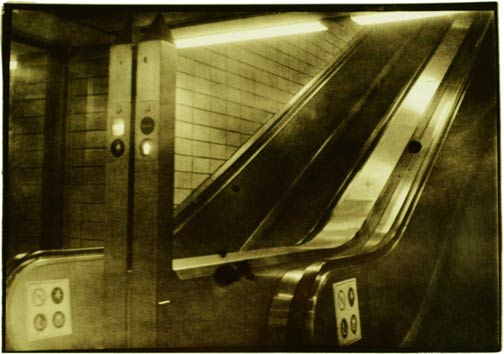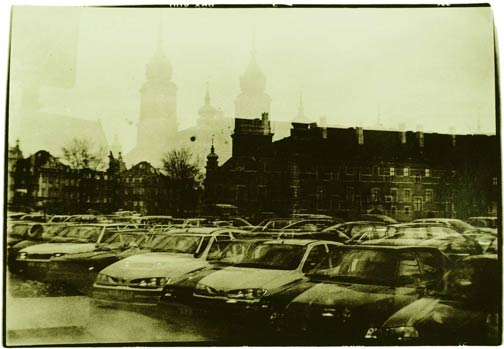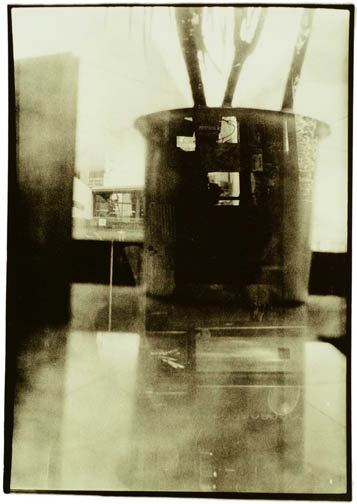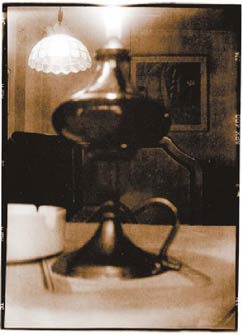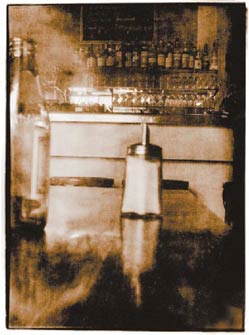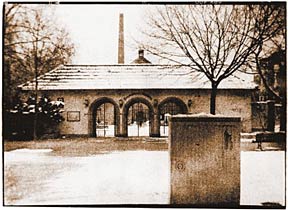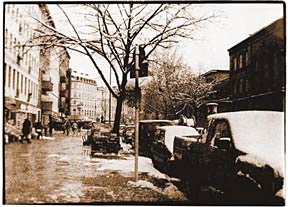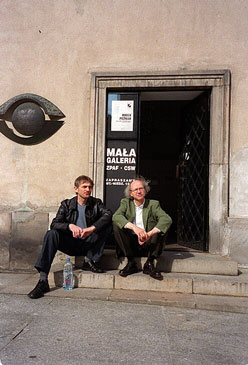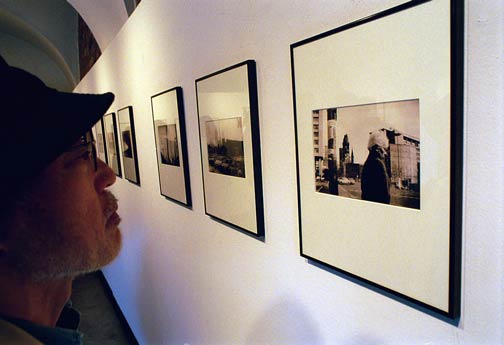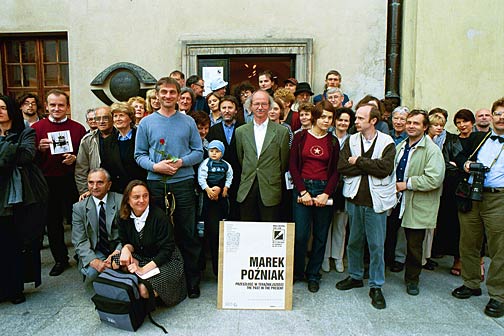Mala Gallery
8, Zamkowy Sq., Warsaw (Old Town)
June 5-29, 2001

Marek Pozniak, "The past in the present" series, Mala Gallery, Warsaw, June 2001
S WE recall, "You press the button, we do the rest" was the advertising slogan when - over a century ago - George Eastman, the founder of the Kodak Empire, simplified photography so that even laymen could arrive at reasonable results. Since then, photography has experienced a complex development: both technically and with regard to the aesthetics of the image. In the meantime, analogous processes are being replaced by digital. In relation to this, Marek Pozniak took a voluntary step back into photographic Stone Age when he began to take pictures with an English amateur camera, probably dating from 1896/97. For this "black box", and here the term applies literally, has none of those technical provisions, which are now part of standard equipment. It has no rangefinder, no alterable apartures, the shutter only permits a choice between permanent opening or momentary exposure, and the optics... well, by today standards, they would not even deserve the name.
But nevertheless, this camera delivers some fascinating pictures - not automatically, cameras have never been able to do that, but in the hands of Marek Pozniak. These, of course, do not produce the photographs, but his imagination and his aesthetic ability to anticipate. This is true of long-term exposures of interiors as well as of the exterior shots, exposed for a shorter time. Basic experience from the history of images is manifest, both in the vertical format with its demarcation at the sides has a tendency to capture restriction and the erect, such as standing human figures, in a symbolic way, we connect a notion of distance with horizontal format, something that has become familiar, even second nature to us from landscapes seen as sweeping natural spectacles. The development of the negative, which consciously aims for a grainy quality and contrast, and the subsequent enlarement on silver-chloride paper lend the motifs a patina which appears old, well suited to the historical technique. Or to put it another way, the appearance eclipses any precise classification in time. Are the photo- graphs from a period in the past? However. if that is the case, why this familiar urban architecture, why these familiar everyday objects?
In this way, although he makes part of his living using the most modern digital technology, Marek Pozniak opposes, on one hand, the technological fetishizm of our age with its high-tech apparatus and new digital production and processing of images, and on the other hand - and this is more significant - he underlines his unqualified faith in the magic of old, analogous photographs. The motifs taken outdoors in the city - in the spirit of street photography, as the distinctive feature of one series - and the motifs resulting from long-term exposure in publicly accessible interiors all demonstrate an irritating, modern forms of the architecture and the appearance of the street, people's clothing or objects. It is true that the modern world is concealed behind antiquated here, but it still remains clearly recognisable. It is Marek Pozniak's individual photographic viewpoint, in connection with the old photographic technique, which makes the past rise up in the present, and which causes a new reality to emerge; a reality which has never been seen before - a photographic reality rousing associations, organised in an aesthetic and therefore artistic way.
Enno Kaufhold
Marek Pozniak, "The past in the present" series, Mala Gallery, Warsaw, June 2001
T IS A TRADITION of Mala Gallery to show new projects of the artists who already have been exhibiting their works here. Sometimes their next exhibition is just development of earlier projects, sometimes they present something totally different, something that opens a new chapter of their work.
This is the case of Marek Pozniak. When some years ago he exhibited - on the occasion of his 33rd birthday - the series of distinctively lighted portraits, nobody could expect that his photography will take another direction. Since some time Marek is using a pinhole camera and an antique sheet film camera from the end of the 19th century. Use of such a technique forces the photographer to approach his subjects in a different way. Pozniak purposely applies old photographic aesthetics to modern motifs that are occuring in landscape, interiors or architecture. There are no sharp edges or clear contours. Because of shallow depth of field objects in foreground are hardly legible. The photographs so composed draw from "the past" being at the same time in "the present" what the artist emphasizes additionally by adequate selection of neutral motifs and subjects of his photographs. This way we feel like that we already saw these photographs much earlier despite we know that they were made not so long ago.
So it seems like that the time in photography is a conventional category and that it may be "stretched out" in both directions. Such conclusions may be drawn after seeing pictures of Marek Pozniak who carries on an interesting dialogue with photography. He tries in very subtle way to prove its timelessness, to say that photo- graph does not have to be tied to a time of its origin. It seems to be somewhat risky idea but in era of computer imaging and digital photography it acquires additional meaning.
Marek Grygiel
Marek Pozniak, "The past in the present" series, Mala Gallery, Warsaw, June 2001
Marek Pozniak, "The past in the present" series, Mala Gallery, Warsaw, June 2001
Marek Pozniak, "The past in the present" series, Mala Gallery, Warsaw, June 2001
Marek Pozniak and Enno Kaufhold in Warsaw. Photo Marek Grygiel
Marek W. Pozniak
born 1960
Education: Higher School of Pedagogy, Opole; Higher School of Engineering, Opole; Higher School of Photography, Warsaw; Goethe Institut, BerlinIndividual exhibitions:
1983 - Stary Czarnkow, Miejski Dom Kultury, Czarnkow
1985 - Fotografie, Mala Galeria (KTZ), Opole; Kwiaty i F, Galeria fg (KMPiK), Bielsko-Biala
1987 - 84 - 86, Galeria Hybrydy, Warsaw; Pogranicza rzeczywistosci, Foto-Medium-Art, Wroclaw i Ladek Zdroj
1988 - Kwiaty i F, Galeria OTF, Olsztyn; Kompozycje... Galeria FF, Lodz
1989 - Filozofom, Dom Kultury, Plock; Memory Photography, Galeria KTZ, Opole 1990 - 10 dni w Berlinie, Foto-Medium-Art, Wroclaw
1991 - Fotografien, Fotogalerie in der Brotfabrik, Berlin; Von 1900 bis 1939, Fotokontakty, Die Zunge, Berlin; Gezeichnete Realitat, Rathaus Steglitz, Berlin 1992 - 800 fotografii na osiemsetlecie, Czarnkow
1993 - 3 Tage Rom, 20 Tage Brotfabrik, Fotogalerie in der Brotfabrik, Berlin; Foto ist Foto, Reiffeisen Galerie in Bamberg;
33, Mala Galeria ZPAF-CSW, Warsaw; Rok 1993, Galeria FF, Lodz
1994 - Porysowane, Galeria Pusta, Katowice; Fotografie, Galerie Mittelstrasse 18, Potsdam
1996 - Foto ist Foto 2, Galeria Instytutu Polskiego, Berlin; Muzeum Narodowe, Gdansk
1997 - Foto ist Foto 2, Galeria Zamek w Reszlu; Galeria Sztuki Wspolczesnej, Opole
1999 - Camera Obscura, BWA Wrocaw - Galerie Design (with Przemek Zajfert)Collective exhibitions:
1984 - Male formaty 1984, Warsaw
1985 - V I Biennale Mlodych, Gliwice
1987 - Warsztat w Gieraltowie, Gieraltow; Krajobrazy swiata, Warszawa; IV (Foto-) Plakat Biennale, Plock
1988 - Fotografia Fotograficzna, Gdansk; Elementary Photography, Brno; Meta-Raum, Dusseldorf; Of Invited, Lodz
1989 - Dyplom '89, Warszawa
1990 - Kontakty, Szczecin, Jelenia Gora, Katowice Elemetary Photography, Castres
1991 - Mai de la Photo, Reims Achim und Nowa Sol, ein Kulturprojekt, Achim Continuum, Berlin Zmiana warty, Lodz, Szczecin; Pomiedzy (II Fotokonferencja), Wroclaw
1992 - Preis fur Junge Europeische Photographen, Berlin, Bad Homburg 1993 - Peron 5, Prague; Obce, Fremd, Strano, Berlin; Konstelacja, Lodz, Berlin
1994 - Modernia Volokuvataieletta Puaolasta, Voipaala, Finland
1995 - Konstelacja II, Munich, Landshut
1996 - From Poland, Perigueux, France; Blizej fotografii, Jelenia Gora, Poznan; Gesten ins Offene, Petzow; Zuhause in der Fremde, Berlin
1997 - Into the Magic, Sarajevo, Ljubljana
1998 - Kontakty, Katowice, Poznan; Pola indywidualnosci, Poznan; Fotografia '98, Krakow; Fotografia i przestrzen, Galeria FF, Lodz
2000 - Ma lerei mit Licht und Pixeln, Das Alte Rathaus, Potsdam
2001 - Malerei mit Licht und Pixeln, Kunst Halle, Guben
Opening of Marek Pozniak's exhibition in Mala Gallery in Warsaw, June 5, 2001. From left: Mala Gallery's Marek Grygiel, the artist Marek Pozniak and dr Enno Kaufhold, the curator. Photo Wojciech Olkusnik/GW
Opening of Marek Pozniak's exhibition in Mala Gallery in Warsaw, June 5, 2001. Pozniak's works examined by Takuya Tsukahara, artist from Japan, who presented his photography in Mala Gallery a year ago, in June 2000. Photo Wojciech Olkusnik/GW
Marek Pozniak and his guests in front of Mala Gallery in Warsaw, Poland. Photo Wojciech Olkusnik/GW
back to FOTOTAPETA's front page
Copyright © 1997-2026 Marek Grygiel / Copyright for www edition © 1997-2026 Zeta-Media Inc.
17 - 06 - 2001
